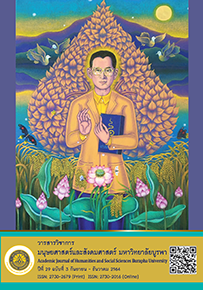Singapore as a Commercial City and Labor Port: The Study of Labor and Trade of the British Colonist between the 19th and 20th Centuries
Main Article Content
Abstract
This article studied the development of Singapore’s history in the 19th and 20th centuries. The objectives of this study were: 1) to investigate Singapore’s development as a British colonial trading port, and 2) to examine trade and development of labor in seaport towns. Using a historical methodology, the data were collected from the records of the indigenous people explored in previous research studies. The key concepts of the article were colonialism and labor liberalization, which reflected the context of Malay Peninsula trading at that time. The results of the study showed that: 1) maritime trade attracted labors and migrants, especially from East Asia and South Asia to Singapore; 2) traditional slave trade was abolished by the British colonial regime and consequently, 3) labor liberalization was encouraged in Singapore. This study brought about an understanding of changing meanings and forms of labor, as well as social development of Singapore as an important colonial seaport in Southeast Asia during the 19th and 20th centuries.
Downloads
Article Details
บทความทุกบทความเป็นลิขสิทธิ์ของวารสารวิชาการมนุษยศาสตร์และสังคมศาสตร์ มหาวิทยาลัยบูรพาเท่านั้น
References
ชุลีพร วิรุณหะ. (2551). บุหงารายา: ประวัติศาสตร์จากคำบอกเล่าของชาวมลายู. กรุงเทพฯ: ศักดิโสภาการพิมพ์.
ชุลีพร วิรุณหะ. (2559). น้ำตาล ข้าว ดีบุก ยางพารา การค้าและการผลิตในเอเชียตะวันออกเฉียงใต้ คริสต์ศตวรรษที่ 19 ถึงสงครามโลกครั้งที่ 2. นครปฐม: โรงพิมพ์มหาวิทยาลัยศิลปากร.
Allen, R. B. (2013). Slave trading, abolitionism, and “new systems of slavery” in the nineteenth-century Indian Ocean world. In R. Harms, B. K. Freamon, & D. W. Blight, Indian Ocean slavery in the age of abolition (pp. 183-199). London: Yale University Press.
Atsushi, O. (2010). The business of violence: Piracy around Riau, Lingga, and Singapore, 1820-40. In R. J. Antony (Ed.), Elusive pirates, pervasive smugglers: Violence and clandestine trade in the Greater China Seas (pp. 127-140). Hong Kong: Hong Kong University Press.
Bankruptcy Court. (1891, July 14). The Singapore free press and mercantile advertiser (Weekly), 4.
Chew, E. C. T. (1991). The foundation of a British settlement. In E. C. T. Chew & E. Lee (Ed.), A history of Singapore (pp. 36-40). Singapore: Oxford University Press.
Freedman, M. (1957). Chinese family and marriage in Singapore. London: H. M. S. O.
Hock, S. S. (1991). Population growth and control. In E. C. T. Chew & E. Lee (Ed.), A history of Singapore (pp. 219-241). Singapore: Oxford University Press.
Jock, A. L. J. (1991). Geographical setting. In E. C. T. Chew & E. Lee (Ed.), A history of Singapore (pp. 3-14). Singapore: Oxford University Press.
Ken, W. L. (1978). Singapore: Its growth as an entrepot port, 1819-1940. Journal of Southeast Asian Studies, 9(1), 50-84.
Ken, W. L. (1991). Commercial growth before the Second World War. In E. C. T. Chew & E. Lee, A history of Singapore (pp. 41-65). Singapore: Oxford University Press.
Mao, H. C. (2020). An album of rare photos: From Chinese coolies to Singaporeans. Retrieved from https://dwvyw8kf1avne.cloudfront.net/s3fs-public/inline-images/19_1.jpg
Pomfret, D. M. (2008). ‘Child slavery’ in British and French Far-Eastern Colonies 1880-1945. Past & Present, (201), 175-213.
Turnbull, C. M. (1977). A history of Singapore 1819-1975. New York: Oxford University Press.
Warren, J. F. (1990). Retrieving prostitutes’ live source materials and an approach for writing the history of the Ah Ku and Karayuki-San of Singapore. Itinerario, 14(1), 96-122.
Warren, J. F. (2007). A tale of two centuries: The globalization of maritime raiding and piracy in Southeast Asia at the end of the eighteenth and twentieth centuries. In P. Boomgaard (Ed.), A world of water: Rain, rivers and seas in Southeast Asian histories (pp. 125-152). Leiden: KITLV Press.


